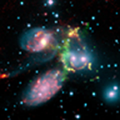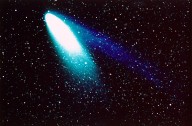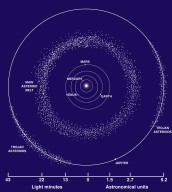Thank you for joining our space mission!

What do you see in this
cluster of star?
Did you know that people have been gazing at the night sky for thousands of years? They were so fascinated by what they saw that they created elaborate stories about it. Their curiosity started the area of science known as Astronomy. Astronomy is the study of what is in the vast expanse beyond earth, and, how and why it it got that way.
What is the Universe?

The Milky Galaxy
Click to watch video explaining
how the universe expands
Courtesy of NASA and CalTech
And, how did it begin? The Universe is everything that exists in space. Scientist think everything started with a giant explosion 13.7 billion years ago. They call this idea "The Big Bang" theory. The universe is always expanding or getting bigger. It contains everything from the smallest object to giant galaxies. A galaxy is a cluster of stars, dust, and gas held together by gravity. Our solar system is in the Milky Way Galaxy. The Milky Way is a spiral of constantly moving stars and the objects (planets, meteorites, comets, etc.) that orbit around them.
Our Solar System

Relative order of
planets in solar system
Our solar system is named after the Latin word, "Sol" which means sun.It is made up of the sun and the planets and other objects that orbit around it. Did you know, that our sun is medium sized a star. There are eight planets in our solar system. The first four inner planets (also called terrestial planets) are: Mercury, Venus, Earth, and Mars.

The Hale-Bopp comet with its two tails
After the terrestial planets is the Asteroid Belt. It's not really a belt. It is an area with lots rocks, comets, and meteroids. Comets are made of frozen gas and rock . They have two tails, a gas tall and a dust tail. When they orbit the sun their tails are always pointed away from it. Halley's Comet orbits the sun once every 76 years. Meteroids are rocks that travel around in space. The larger meteroids come from the Asteroid Belt.
Outside the Asteroid Belt are the outer planets. These outer planets are called the "Jovian planets" or gas planets. They are Jupiter, Saturn, Uranus, and Neptune. Beyond Neptune is Pluto, a dwarf planet. The other known dwarf planets are: Ceres, Eris, Haumea, and Makemake.
Now that you know a bit about our universe and solar system lets review...
Objects in our Solar System Quiz:
What galaxy is our solar system in?
A. The Milky Way Galaxy
B. The Centauri Galaxy
C. The Cereal Galaxy
D. The Asteroid Belt
What is at the the center of solar system?
A. Gases surrounded by ice
B. The Asteroid Belt
C. Pluto
D. The sun
Comets are other objects that are in outer space that are not planets. They are made of?
A. Rock
B. Water
C. Red
D. Frozen gas and rock
What are small pieces of rock that travel around in the asteroid belt?
A. Comets
B. Space dust
C. Dwarf planets
D. Meteoroids
 The Sun |
StarChild Level 1 (click |
 Asteroid Belt |
StarChild Level 1 (click |
 Comets |
StarChild Level 1 (click |
 Asteroids/Meteroids |
StarChild Level 1 (click |
Its time to blast off to explore the planets. There you will visit the "Planets WebQuest." Your mission there will be to decide which is the most interesting planet and become an expert about it. Next, you and a partner, will create a commercial (using Photostory) to convince NASA that it is the BEST planet in the solar system and they should fund its exploration now!
When you have finish your planets mission. Your next stop will be the Stars, in this mission you will explore how stars are born, live, and die. Your final mission will be the Night Sky, Here you will learn about how and why the planets and stars look the way they do in the night sky. Of course, if you need help, your media specialist and teacher will be here to help guide you through the steps.




